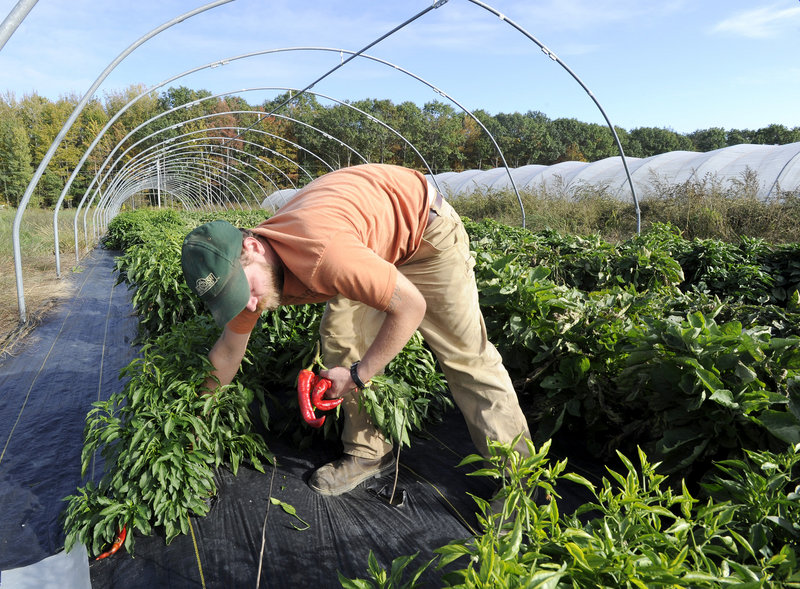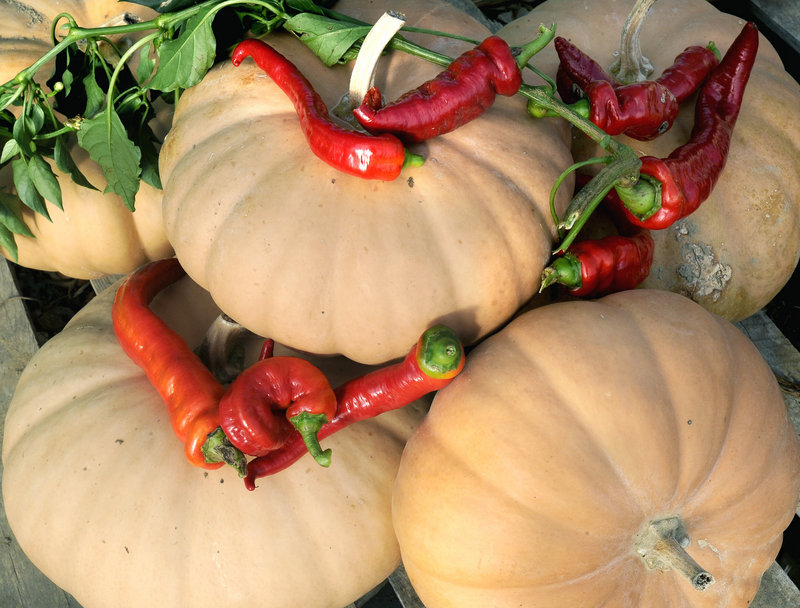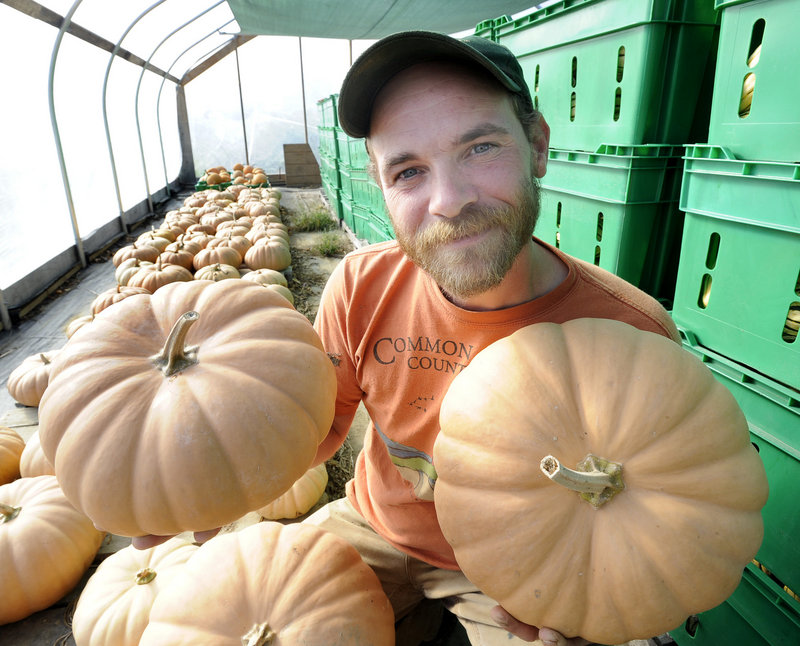BOWDOINHAM — Chris Cavendish clipped a bright, stunning red pepper from a group of about 30 plants he tended this year at Fishbowl Farm. He took a big bite right where he stood, and the Jimmy Nardello sweet Italian frying pepper, named after a 19th-century seed saver, rewarded him with a satisfying crunch and burst of flavor.
“They have a fruitiness and almost a tanginess at the finish of the pepper that other sweet peppers don’t have,” Cavendish said.
The Jimmy Nardello pepper originated in Basilicata, a southern region of Italy. Nardello brought the seeds with him to Connecticut in 1887, but 123 years later, most people have never tasted the 10- to 12-inch-long fruits of the plant.
Here’s your chance. The peppers that Cavendish grew this summer are just one of a dozen rare vegetable varieties that will be prepared by local chefs and served Sunday at the second annual American Harvest Picnic sponsored by Slow Food Midcoast Maine.
These hard-to-find foods have been tagged by Slow Food USA’s RAFT program as in danger of disappearing from America’s dinner tables. RAFT stands for Renewing America’s Food Traditions.
Foods that end up on the RAFT list – they include everything from nuts to meat and poultry – are traditional regional foods that have lost favor for some reason. In many cases, they have been replaced by foods grown in industrial agriculture operations that are then mass-marketed in grocery stores.
“We’ve all been programmed into seeing things that are perfectly red, perfectly round, perfectly green, but that’s not really what historically food was,” says Kim Wisneski, who has acted as Slow Food’s liaison with midcoast farmers.
Some of the RAFT foods have such deep cultural roots and such an interesting flavor profile that they have been placed on the Ark of Taste, a list of more than 200 regional foods in danger of extinction.
For these endangered foods, Wisneski said, “Our hope is that it finds its way back in the marketplace, or find its way back on the menu at restaurants.”
To support that goal, the Midcoast Maine chapter of Slow Food enlisted the help of seven local farmers to grow a dozen crops on the RAFT list for the American Harvest Picnic. Half of those RAFT foods are also on the Ark of Taste list, including the Jimmy Nardello pepper.
The seeds for the picnic project were donated by Fedco and Johnny’s Selected Seeds.
The farmers have been asked to donate a small amount of their RAFT crops to the picnic, but they will be able to keep most of them to sell at local farmers’ markets.
ON THE MENU
Chefs from nine restaurants have agreed to create special dishes with the vegetables that will showcase their flavor and appearance.
Cafe Miranda in Rockland will be working with local beef, local organic apples from Sewall Orchards and Early Jersey Wakefield cabbage, a variety that is on the RAFT list and grown by Phoenix Farm in Monmouth.
“We’re going to cure and applewood-smoke the beef and then braise it in our homemade barbecue sauce,” said Kerry Altiero, owner of Cafe Miranda. “And then we’re going to make a crispy slaw vinaigrette with the apples in it for the beef.”
At Solo Bistro in Bath, chef Tony Lavelle will put his own spin on the same RAFT ingredient. He’ll be serving beer-braised Early Jersey Wakefield cabbage with a wedge of Pineland Farms cheddar and a scoop of savory Ricker Hill Orchard apple bread pudding.
Chef Daran Poulin of Bowdoin College will be using Long Island cheese squash grown by Chris Cavendish at Fishbowl Farm to make a pumpkin bisque. Cavendish estimates he grew at least 1,000 pounds of this “heavy, dense, meaty squash.”
“It was actually a very popular squash at the turn of the century, obviously grown on Long Island and shipped to the cities and sold to immigrants,” Winglenski said. “It’s supposed to make just incredible soup, and it’s supposed to be very good baked.”
Gallit Sammon, Cavendish’s fiancee and a former chef, thinks the squash makes a nice soup because it has a higher water content than other varieties. She recently tried making some herself, and said it was “delicious.”
First, she pierced the squash and lightly rubbed it with olive oil. Then she roasted it until it was tender. While it was cooling, she sweat some onions and leeks in olive oil in a pot. Then she scooped out the flesh of the squash and added that, along with a little vegetable stock.
She let it cook until the flavors blended, then added a little cream. The entire mixture was blended with butter, salt and pepper, “and that was it. Really, a little bit (of seasoning). It was just the squash.”
The squash does have a unique flavor, Sammon said, “but it would be hard to describe. It’s a nice flavor. It’s not very grainy, so it has a nice texture after you cook it.”
Another food that will be featured at this year’s picnic is the Jacob’s cattle bean, a Prince Edward Island heirloom on the Ark of Taste. The plump, red-speckled bean was said to be a gift from Maine’s Passamaquoddy Indians to Joseph Clark, the first white child born in Lubec.
David Buchanan of Old Ocean House Farms is growing Canada crookneck squash, a bottle-shaped winter squash that is an ancestor of the modern butternut squash. The Canada crookneck, already on the Ark of Taste, is so endangered that Buchanan had to get his seeds from Old Sturbridge Village in Massachusetts, where they are being grown in the historic gardens.
“It’s delicious, it’s a very manageable size and it grows beautifully, so I’m not sure why it’s become so endangered,” Buchanan said. “But it is only available commercially from one company in Canada. No one in this country is carrying it.”
Buchanan has roasted one or two of the dozens of crooknecks he’s grown this year.
“It’s like a butternut,” he said. “It’s got a nice sweetness. We’ve only had a couple of them, so I can’t say a lot yet, but I like the texture. It’s a smooth texture.”
‘CULTURAL ROOTEDNESS’
Buchanan knows what he’s talking about. Not only does he like to grow unusual and interesting varieties of vegetables and fruits, he is on the national Ark of Taste committee that chooses which foods will be listed. The foods have to have place-based traditions, interesting stories of cultural rootedness, “and they have to taste good,” Buchanan said.
The 10 members of the committee get together once a year at a restaurant and work with the chef, who brings out dishes made with threatened foods one by one for the committee to taste. The last meeting was in Madison, Wis., just three weeks ago.
On the table this year were two varieties of potatoes with interesting back stories. One was an extremely rare potato that came to North America directly from South America rather than Europe. The Bodega Red potato, the story goes, was brought to California by a Peruvian in 1840. The Red McClure potato had an interesting history in Colorado.
“It’s not just squash varieties,” Buchanan said. “We’ll taste fish and shellfish and meats. At the last meeting we tasted rye whisky, and we tasted a Cincinnati meat product called goetta, which is kind of a scrapple-like product. It’s a mixture of oats and meats, and it’s kind of sausage-like. It’s largely a breakfast food.”
No new foods from Maine were added to the Ark this time around, Buchanan said. He asks any Mainers who have ideas about foods that could help restore the region’s cultural and biological diversity to come forward.
“Anyone can nominate foods that they feel are worthy of the Ark, and we encourage individuals outside of the committee to do that,” he said.
Meanwhile, travel to Morris Farm on Sunday and take a trip back in time enjoying the heritage foods served at the American Harvest Picnic.
Staff Writer Meredith Goad can be contacted at 791-6332 or at: mgoad@pressherald.com
Send questions/comments to the editors.






Success. Please wait for the page to reload. If the page does not reload within 5 seconds, please refresh the page.
Enter your email and password to access comments.
Hi, to comment on stories you must . This profile is in addition to your subscription and website login.
Already have a commenting profile? .
Invalid username/password.
Please check your email to confirm and complete your registration.
Only subscribers are eligible to post comments. Please subscribe or login first for digital access. Here’s why.
Use the form below to reset your password. When you've submitted your account email, we will send an email with a reset code.